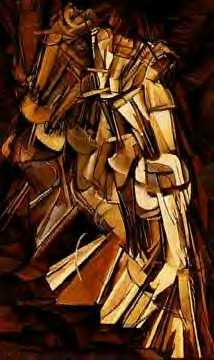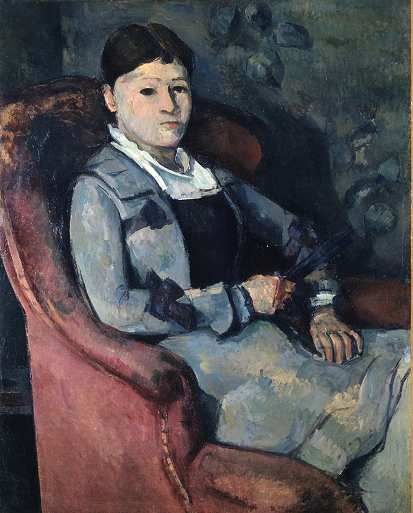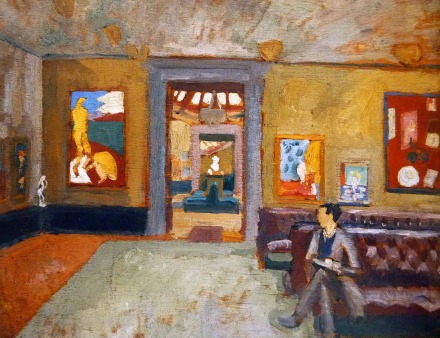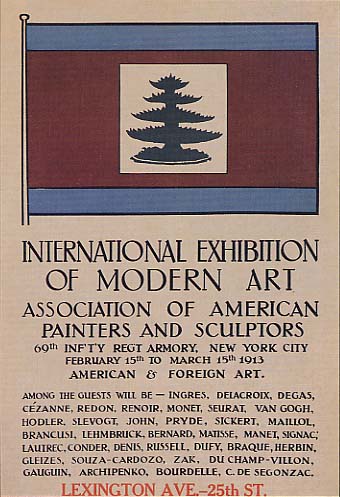New York City, Spring, 1913
All the buzz is about the Armory Show.
From mid-February to mid-March cars and carriages pull up in front of the 69th Regiment Armory at Lexington Avenue between 25th and 26th Streets, loaded with people eager to see America’s first International Exhibition of Modern Art. Office girls come on their lunch hours; working class families come on weekends, and the social elite come again and again. They stare and laugh at the horrors they have read about in the press. Is it Nude Descending a Staircase? Or Staircase Descending a Nude? Who can tell?
Those more sophisticated, who think of the Impressionists as the latest thing, are surprised to find that indeed the Post-Impressionists are all the rage in Europe. One of the most well represented artists is the late Paul Cezanne, in Paris considered an old master by now; the most talked about is Henri Matisse, 43; and that “Paul” Picasso, only 31? Just plain crude.
John Quinn, 42, is ecstatic. He has worked closely with the American Association of Painters and Sculptors [AAPS] in the build up to the show—asking for lends of paintings from his art collecting friends, testifying before Congress to lower the taxes on art coming into the US from Europe, and promoting the exhibit every chance he gets.
He comes to the show almost every day, and buys paintings almost every day as well.
Uptown, 20-year-old Dorothy Rothschild—
“No, we’re not related to those Rothschilds”
—is living on her own in her hometown of New York City for the first time. Her father died this year; her mother had passed away when she was three. She has a job using the skills she learned at finishing school—playing the piano at a dancing academy. When she was younger, Dottie and her father had written nonsense poems back and forth to each other. Now she is trying light verse, sending it to The Evening Mail newspaper column, ‘All in Good Humor’ by FPA, 31, that publishes that sort of filler, hoping to get her name in print.

Marcel Duchamp’s Nude Descending a Staircase, No. 2, 1912
Paris, Spring, 1913
The art dealers in Paris are awaiting the verdict from New York. How will the wealthy American collectors react to the paintings in the Armory Show? Will they really pay US$48,000 for a Cezanne? Hundreds of dollars for drawings by the young Spaniard, Pablo Picasso? And the Show organizers are going to send some of the most valuable paintings off to other cities—Chicago! Boston! What are they thinking? The few Americans who come to Paris to buy are shocked by what they see in the dealers’ galleries. How will they react when they see the same scandalous works lined up with the latest by their own American artists?
Quinn himself had been to Paris the previous autumn for a quick trip. He had encouraged Walter Kuhn, 35, and Arthur B. Davies, 50, from the AAPS to go abroad and pick up all they can for their show, sending introductory letters to all his European contacts.
Seven of the Armory Show’s paintings have been lent by American collectors living in Paris. Gertrude Stein, just turned 39, and her brother, Leo, 40, ex-patriates from San Francisco, have used their family money to put together quite a collection of works they personally feel connected to—Matisse, Picasso and his friend, Georges Braque, 30. They enjoy meeting the painters and talking to them in their salon at 27 rue de Fleurus. Late at night, Gertrude sits at a desk in front of Madame Cezanne with a Fan and tries to create in words what Cezanne created on canvas. A few of her attempts at translating Cubism into prose have been published in the States recently and are being publicized as part of the Armory Show.
Another San Franciscan, Alice B. Toklas, 35, had come to visit a few years before and then moved in with Gertrude and Leo. She had quickly taken on the role of handmaiden to the writer, cooking, cleaning, typing. Their relationship has grown so close that Gertrude’s brother feels he has to move out. Soon.

Paul Cezanne’s Mme. Cezanne with a Fan, 1904
London, Spring, 1913
This spring, Gertrude and Alice are visiting London. They have come to find a publisher for Stein’s work, and spend time socializing with artists and writers there.
Kuhn and Davies had come to London the previous year to see the Second Post-Impressionist art show put on by Roger Fry, 46. They requested so many paintings that Fry had been forced to close his show early. The Second show had a better reception from the average Brit than the first, just two years before. Once the English had gotten used to Cezanne, they were more open to Matisse.
The Second show has been organized by Fry’s friends, artists and writers who live in the bohemian Bloomsbury section of London. They had come together in the homes of two sisters, Virginia Woolf, 31, married less than a year before, and Vanessa Bell, 33, a painter whose work was included in the London show. The family had decided early on that Vanessa would be the artist and Virginia would be the writer. Neither had traditional schooling, although Vanessa had attended art school and Virginia had had the run of her father’s library. Some reviews and small pieces of Virginia’s had been published in local papers, but now she is working on her first novel. The only person she would show it to, and not until she feels it is finished, is her new husband, Leonard, 32.
Virginia’s Bloomsbury friends are encouraging her. They get together most Thursdays at Vanessa’s house in Gordon Square to have dinner, then whiskey, buns and cocoa—and conversation and cigarettes late into the night.

Vanessa Bell’s Matisse Room, 1912
Ireland, Spring, 1913
In Ireland all the talk is of the recent passage of Home Rule in the British House of Commons. Will this be the first step towards complete independence for the restless colony?
A strong Irish nationalist movement had been agitating for years, through political organizations to keep the language alive, like the Gaelic League, and cultural organizations to keep Irish folk arts alive, such as the Abbey Theatre. The Abbey presents plays in English, but based on Irish folk tales and legends gathered in the west of Ireland.
Quinn had met the founders of the theatre on his first trip to Ireland 11 years ago. Since then, he has supported their theatre with legal advice as well as cash. When any of his Irish friends visit New York, they stay with Quinn and his paintings in his Upper West Side apartment.
One of the theatre’s founders, the poet William Butler Yeats, 47, is still involved in the operations of the Abbey, but most of the work now falls to his original collaborator, Lady Augusta Gregory, 61.
This spring, Augusta is touring the United States with the Abbey for the second time. Two years ago when they performed the late JM Synge’s The Playboy of the Western World, they had legal trouble in Philadelphia, but it was nothing compared to the riots that had broken out in Dublin when it premiered there four years before. Quinn had argued their case in Philadelphia and gotten them out of jail so they could continue their tour.
But now her trip is almost over. She is in New York, staying with Quinn, and is looking forward to taking in the Armory Show, where some of her friends’ works are exhibited.
Quinn has offered to escort Augusta around, pointing out the paintings he is most proud of.
Mostly, she wants to see what all the fuss is about.

Poster for the original Armory Show, 1913
To walk with me and the ‘Such Friends’ through Bloomsbury, download the Virginia Woolf and the Bloomsbury Group audio walking tour from VoiceMap.
Manager as Muse explores Scribner’s editor Maxwell Perkins’ work with his ‘Such Friends,’ F. Scott Fitzgerald, Ernest Hemingway and Thomas Wolfe and is available on Amazon in both print and Kindle versions.